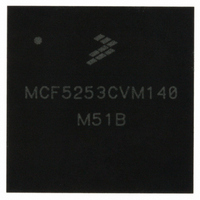MCF5253CVM140 Freescale Semiconductor, MCF5253CVM140 Datasheet - Page 178

MCF5253CVM140
Manufacturer Part Number
MCF5253CVM140
Description
IC MPU 32BIT 140MHZ 225-MAPBGA
Manufacturer
Freescale Semiconductor
Series
MCF525xr
Datasheets
1.MCF5253VM140J.pdf
(34 pages)
2.MCF5253VM140J.pdf
(8 pages)
3.MCF5253VM140J.pdf
(648 pages)
4.MCF5253VM140J.pdf
(2 pages)
Specifications of MCF5253CVM140
Core Processor
Coldfire V2
Core Size
32-Bit
Speed
140MHz
Connectivity
CAN, EBI/EMI, I²C, QSPI, UART/USART, USB OTG
Peripherals
DMA, WDT
Program Memory Type
ROMless
Ram Size
128K x 8
Voltage - Supply (vcc/vdd)
1.08 V ~ 1.32 V
Data Converters
A/D 6x12b
Oscillator Type
External
Operating Temperature
-40°C ~ 85°C
Package / Case
225-MAPBGA
Family Name
MCF5xxx
Device Core
ColdFire V2
Device Core Size
32b
Frequency (max)
140MHz
Instruction Set Architecture
RISC
Supply Voltage 1 (typ)
1.2/3.3V
Operating Supply Voltage (max)
1.32/3.6V
Operating Supply Voltage (min)
1.08/3V
Operating Temp Range
-40C to 85C
Operating Temperature Classification
Industrial
Mounting
Surface Mount
Pin Count
225
Package Type
MA-BGA
Lead Free Status / RoHS Status
Lead free / RoHS Compliant
Number Of I /o
-
Eeprom Size
-
Program Memory Size
-
Lead Free Status / Rohs Status
Compliant
Available stocks
Company
Part Number
Manufacturer
Quantity
Price
Company:
Part Number:
MCF5253CVM140
Manufacturer:
FREESCALE
Quantity:
300
Company:
Part Number:
MCF5253CVM140
Manufacturer:
Freescale Semiconductor
Quantity:
10 000
Part Number:
MCF5253CVM140
Manufacturer:
FREESCALE
Quantity:
20 000
Company:
Part Number:
MCF5253CVM140J
Manufacturer:
Freescale Semiconductor
Quantity:
10 000
- MCF5253VM140J PDF datasheet
- MCF5253VM140J PDF datasheet #2
- MCF5253VM140J PDF datasheet #3
- MCF5253VM140J PDF datasheet #4
- Current page: 178 of 648
- Download datasheet (8Mb)
Chip Select Module
10.2.2
CS1 has a programmable address range, wait state generation, and internal/external termination. A reset
clears all chip select programming. It is multiplexed with QSPI_CS3 and GPIO28.
10.2.3
CS2 provides two separate control signals for read and write operations. These two signals go active during
CS2 cycles. IDE_DIOR can be programmed to go active on read and write cycles, or only to go active on
read cycles. IDE_DIOW operates only on write cycles.
IDE_DIOR and IDE_DIOW can be used as enables to access an IDE drive or another AT-bus peripheral.
This added functionality allows users to insert more than 16 wait states on IDE_DIOR, IDE_DIOW, and
allows dynamic cycle termination using the IDE_IORDY signal.
10.2.4
There is no physical output pin. However, the registers for CS3 are available and can be used to enable the
BUFENx outputs. These BUFENx outputs could then be used as a physical CS3. This would require
programming the CS3 registers and then setting the appropriate bits in the IDECONFIG1 register. See
Table 13-2, IDEConfig1 Register Field Descriptions
10.2.5
The OE signal enables read accesses to memory and/or peripherals. It is asserted and negated on the falling
edge of the clock. This signal is asserted when there is a match with one of the chip selects.
10.2.6
The BUFENB1/GPIO29 and BUFENB2/GPIO30 signals are intended to enable bus buffers which will
provide isolation / buffering between the MCF5253 high speed memory bus and additional external
memory mapped devices.
BUFENB1 is always active on CS0.
BUFENB2 is always inactive on CS0. It is programmable to be active on CS1, CS2, CS3 (special case)
and CS4 as desired.
10.2.7
The IDE_IORDY signal controls the insertion of wait states on CS2.
10-2
CS1/QSPI_CS3/GPIO28
CS2 — IDE_DIOR/GPIO31 and IDE_DIOW/GPIO32
CS3
Output Enable Signal OE
Buffer Enable – BUFENB1 and BUFENB2 Signals
Bus Termination Signal – IDE_IORDY
MCF5253 Reference Manual, Rev. 1
for bit 18 or 21 settings.
Freescale Semiconductor
Related parts for MCF5253CVM140
Image
Part Number
Description
Manufacturer
Datasheet
Request
R
Part Number:
Description:
Mcf5253 Coldfire? Microprocessor Data Sheet
Manufacturer:
Freescale Semiconductor, Inc
Datasheet:
Part Number:
Description:
Manufacturer:
Freescale Semiconductor, Inc
Datasheet:
Part Number:
Description:
Manufacturer:
Freescale Semiconductor, Inc
Datasheet:
Part Number:
Description:
Manufacturer:
Freescale Semiconductor, Inc
Datasheet:
Part Number:
Description:
Manufacturer:
Freescale Semiconductor, Inc
Datasheet:
Part Number:
Description:
Manufacturer:
Freescale Semiconductor, Inc
Datasheet:
Part Number:
Description:
Manufacturer:
Freescale Semiconductor, Inc
Datasheet:
Part Number:
Description:
Manufacturer:
Freescale Semiconductor, Inc
Datasheet:
Part Number:
Description:
Manufacturer:
Freescale Semiconductor, Inc
Datasheet:
Part Number:
Description:
Manufacturer:
Freescale Semiconductor, Inc
Datasheet:
Part Number:
Description:
Manufacturer:
Freescale Semiconductor, Inc
Datasheet:
Part Number:
Description:
Manufacturer:
Freescale Semiconductor, Inc
Datasheet:
Part Number:
Description:
Manufacturer:
Freescale Semiconductor, Inc
Datasheet:
Part Number:
Description:
Manufacturer:
Freescale Semiconductor, Inc
Datasheet:
Part Number:
Description:
Manufacturer:
Freescale Semiconductor, Inc
Datasheet:











